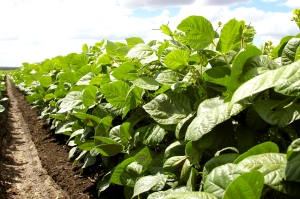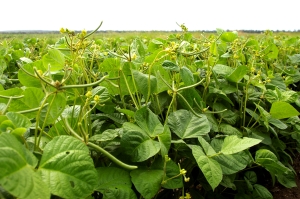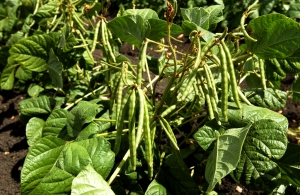Paddock Practices: Making more from irrigated mungbeans
Paddock Practices: Making more from irrigated mungbeans
Date: 31 Jul 2019

Research has identified significant opportunities to boost the yield and water use efficiency (WUE) of irrigated mungbean crops across Queensland and New South Wales by equipping growers with improved information on agronomic and irrigation management.
While average on-farm yields range from 1-2.5 tonnes per hectare across the northern grains region, simulation outputs undertaken as part of the research showed a benchmark irrigated yield potential of 2.6-3.0 t/ha.
Closing this yield gap and maximising gross margin per megalitre of water will rely on improving the scheduling and rates of applied irrigation as well as crop agronomic management in areas such as planting timing, fertiliser application, plant population and desiccation timing.
A collaborative investment between the Grains Research and Development Corporation (GRDC) and CSIRO, the research included an extensive survey of current practices and the results suggest opportunities to improve yield lie in two key areas:
- Irrigation scheduling – While most irrigations are applied at currently recommended timings (flowering and early pod-fill), there is large variation in the timings and amounts of irrigations applied (from 0.2-9.0 megalitres (ML) per hectare) particularly during the vegetative period and after flowering. In many cases, there appears to be potential to reduce irrigation applications to more closely match crop seasonal demand.
- Crop nutrition – There is limited use of fertilisers in mungbeans in many cases, indicating a lack of information or evidence on the nutrition requirements of these crops under higher yield potentials, particularly the economics of nitrogen (and in some regions phosphorus and potassium) applications.
CSIRO research technician Skye Traill said simulations indicate there is little yield response above 2.5 ML/ha across production environments and seasons, yet, 50 per cent of flood irrigators and 10 per cent of overhead irrigators apply more than this.
“By building a greater understanding of yield responses to irrigation applications as well as an understanding of the water inputs requirements through the season, it may be possible to increase WUE and returns per ML for mungbean crops,” Ms Trail said.
“Based on these water requirements, irrigated mungbeans can compare favourably with other irrigated summer crops such as cotton and sorghum in terms of gross margin per ML, especially when mungbean prices are high relative to other crops.
“This is going to be particularly relevant in regions where water availability, not land area, limits production.”

Refining irrigation practices
The survey confirmed that irrigation scheduling is highly variable both within and between production regions.
While most schedules fit within industry guidelines by irrigating around flowering and early pod development, 78 per cent of growers were found to irrigate outside this window by irrigating pre-plant or during vegetative growth or late pod fill.
“Over irrigating during vegetative growth will reduce WUE, however current guidelines to limit flood irrigations to reproductive growth may not suit lower plant available water capacity soils or overhead systems,” Ms Traill said.
“Given this, the majority of growers appear to be irrigating at the key times of flowering and early pod fill however, there is no information available on timing irrigations outside this window.”
Maximising crop production and returns also relies on optimising irrigation rates however the research suggests that current recommendations of 3.5-4.5 ML/ha may overestimate irrigation requirements with 58 per cent of flood irrigators and 100 per cent of overhead irrigators applying ≤3 ML/ha.
“Simulations demonstrated that 1-3 ML/ha maximised crop WUE, allowing growers to maximise the yield response to irrigation water applied,” Ms Traill said.
“Therefore, significant opportunities exist to increase crop yield and WUE through improved understanding of crop water requirements in different regions and the optimum time to apply this water based on soil type, yield potential, seasonal conditions, irrigation type and water allocation.”

Where to with agronomy?
Survey results indicate that there are four key agronomic factors that may be manipulated to increase on-farm yield:
- Planting timing - optimising planting timing to reduce production risk, especially heat stress, rain at harvest and pest and disease pressure. Information on how production risk varies with planting timing will assist with planting decisions, especially in opportunistic systems where soil water or irrigation water availability can mean planting is not within the optimum window.
- Soil fertility management – the survey found soil fertility management practices varied significantly among growers. Only half of those surveyed apply starter fertiliser and while some growers don’t fertilise as they don’t receive a yield response, a number of growers based this decision on very little empirical information according to Ms Traill.
“Improved monitoring of soil fertility will help identify crops where starter fertiliser will provide a yield benefit,” she said.
“At the same time, the industry would benefit from clearer guidelines on the yield benefit and economic value of N applications under high yielding conditions.”
- Plant populations – irrigated mungbeans are currently being grown at plant populations of 20-47 plants/m2, with 43 per cent of growers planting outside the recommended plant population according to the survey results
“While this may be driven by concerns about disease or lodging or aiming to increase yield potential, this indicates that there is scope to improve yield potential by targeting optimum plant populations,” Ms Traill said.
- Desiccation timing - growers indicated that it was difficult to time desiccation due to seasonal conditions and variable levels of crop maturity.
Ms Traill said information on desiccation timing based on pod maturity levels and the weather forecast (days to next rainfall event) would assist growers with this decision.
The survey findings are being used to inform a number of existing research projects including mungbean physiology, agronomy and irrigation scheduling in partnership with the University of Queensland, Department of Agriculture and Fisheries and CSIRO. It’s expected that these research projects will help address some of the current information gaps and contribute to more informed industry management recommendations.
More information
Kaara Klepper, GRDC, Kaara.Klepper@grdc.com.au
Useful Informaiton
GRDC GrowNotes mungbeans https://grdc.com.au/resources-and-publications/grownotes/crop-agronomy/grownotesmungbeansnorthern
GRDC Project Code: CSP1806-010RTX,
